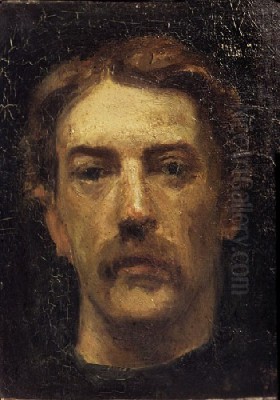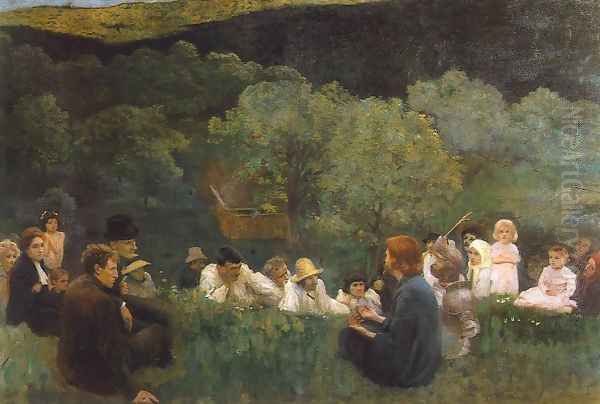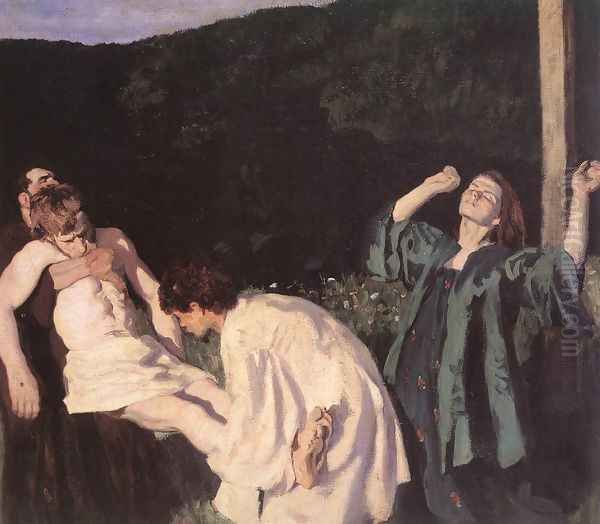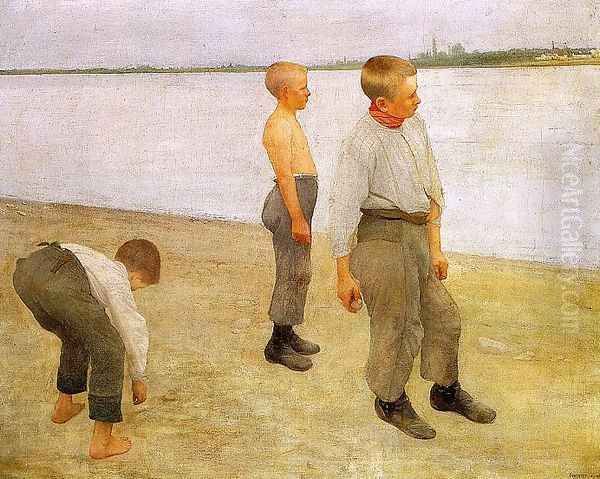
Károly Ferenczy stands as a monumental figure in the annals of Hungarian art history. Born in Vienna in 1862 and passing away in Budapest in 1917, his life and career bridged the transformative period from late 19th-century academic traditions to the burgeoning movements of modernism. Widely revered as the "father of Hungarian Impressionism and Post-Impressionism," Ferenczy was not merely a follower of European trends but a pivotal innovator who synthesized international styles with a unique Hungarian sensibility, fundamentally shaping the course of his nation's art. His leadership in the Nagybánya artists' colony and his influential teaching career further cemented his legacy as a cornerstone of modern Hungarian painting.
Early Life and the Call to Art
Károly Ferenczy's journey into the world of art was not a direct path. Born into a German-speaking family in Vienna, his early life saw a move to Budapest following his father's professional relocation. It was during this period that the family context shifted, and Károly, initially known as Karl Freund, embraced his Hungarian identity. His initial academic pursuits led him to study law, a conventional path perhaps expected for a young man of his background at the time. However, the latent passion for visual arts simmered beneath the surface.
A significant turning point came with the encouragement of his cousin and future wife, Olga Fialka, herself a painter. Recognizing his innate talent and artistic inclinations, she played a crucial role in persuading him to abandon his legal studies and dedicate himself fully to painting. This decision, made around 1884, marked the beginning of a profound commitment to art. Further solidifying this path, Ferenczy traveled to Italy in 1885 before formally commencing his artistic education.
His formal training began at the Academy of Fine Arts in Naples in 1886. However, seeking broader horizons and exposure to the latest artistic currents, Ferenczy made the pivotal move to Paris in 1887. This relocation placed him at the vibrant heart of the European art world during a period of intense experimentation and change.
Formative Years: Paris and Munich

Paris in the late 1880s was a crucible of artistic innovation. Ferenczy enrolled at the Académie Julian, a renowned private art school that attracted students from across the globe. Unlike the more rigid official École des Beaux-Arts, the Académie Julian offered a more liberal environment, fostering diverse styles. Here, Ferenczy absorbed the prevailing influences, particularly the lingering impact of Naturalism and the burgeoning force of Impressionism.
He was particularly drawn to the works of artists associated with Naturalism and plein-air painting, such as Jules Bastien-Lepage. Bastien-Lepage's emphasis on direct observation, truthful depiction of rural life, and nuanced handling of light resonated deeply with Ferenczy's own inclinations. While in Paris, he also undoubtedly encountered the revolutionary works of the Impressionists like Claude Monet and Camille Pissarro, whose approaches to capturing fleeting moments, light, and color were transforming the artistic landscape.
Following his Parisian sojourn (until 1889), Ferenczy sought further refinement, moving to Munich, another significant art center. There, he associated with the circle of Hungarian artists studying under Simon Hollósy. Hollósy ran a popular private school that championed realism and plein-air painting, offering an alternative to the Munich Academy's conservatism. This period was crucial for Ferenczy, connecting him with fellow Hungarian artists who shared similar aspirations and fostering a sense of collective purpose that would soon find expression back in their homeland. He also spent time back in Szentendre, near Budapest, honing his skills before a major career development.
The Nagybánya Artists' Colony: A Hungarian Barbizon
The year 1896 marks a watershed moment in Hungarian art history with the establishment of the Nagybánya artists' colony (now Baia Mare, Romania). Dissatisfied with the constraints of academic training and inspired by the example of the Barbizon School in France, Simon Hollósy led a group of his students, including Ferenczy, István Réti, János Thorma, and Béla Iványi-Grünwald, to this picturesque mining town nestled in the Carpathian foothills. Their goal was to work directly from nature, capturing the unique light and atmosphere of the Hungarian landscape.
Ferenczy quickly emerged as a central figure and leading personality within the colony. While Hollósy provided the initial impetus, Ferenczy's artistic maturity, dedication, and evolving style made him a natural leader, especially after Hollósy began spending less time there. Nagybánya became a vibrant hub, attracting generations of artists and fostering a distinctive style characterized by plein-air techniques, a brightened palette influenced by Impressionism, and a commitment to depicting Hungarian life and landscape.

Ferenczy spent his summers in Nagybánya from 1896 until his death, and the colony became the primary subject and inspiration for his work during this crucial period. He was not only a prolific painter there but also a respected teacher, guiding younger artists and shaping the colony's artistic direction. Nagybánya represented a decisive break from the historical and academic painting that had dominated Hungarian art, paving the way for modernism.
Evolution of Style: From Naturalism to Synthetism
Ferenczy's artistic journey reflects a continuous evolution, absorbing contemporary influences while forging a distinct personal style. His early works, created before and during his initial Nagybánya years, show the strong influence of Naturalism, particularly the detailed observation and somewhat muted palette associated with Bastien-Lepage and the Munich school. Boy Throwing Stones (1890) exemplifies this phase, with its careful rendering of form and focus on a scene from everyday life.
The move to Nagybánya and sustained engagement with plein-air painting led to a significant brightening of his palette and a looser brushwork, clearly reflecting the influence of Impressionism. He became adept at capturing the effects of sunlight and atmosphere, though he rarely dissolved form to the extent seen in French Impressionism. Girl by the Window (1893), though predating the colony's formal establishment, already shows a sensitivity to light that would become central to his work.
Ferenczy developed what is often termed "coloristic naturalism," a synthesis that retained a strong foundation in observed reality while employing color more expressively and analytically. He explored the interplay of light and shadow, often using complementary colors to create vibrant effects. Works like Birdsong (circa 1893) showcase this developing style, balancing realistic depiction with a heightened sense of color and light that borders on the poetic.
In his later years, particularly after 1906 when he began spending more time in Budapest due to his teaching appointment, Ferenczy's style continued to evolve. Influenced by Post-Impressionist trends, his work demonstrated a move towards greater synthesis, simplification of forms, and a more decorative use of color and line. Echoes of artists like Pierre Bonnard or even Paul Gauguin can be discerned in the flattened perspectives and bold color areas of some later compositions. He integrated figures more monumentally into landscapes, often imbuing them with symbolic or biblical significance, but always grounded in the visual language he had honed at Nagybánya.
Major Themes and Representative Works
Throughout his mature career, Ferenczy explored several key themes, often returning to them with fresh perspectives as his style evolved. Landscapes, biblical scenes, portraits, and nudes form the core of his oeuvre.

Landscapes: The Nagybánya landscape was an inexhaustible source of inspiration. Ferenczy painted the surrounding hills, forests, fields, and the town itself under varying conditions of light and season. Summer Evening (1904) captures the tranquil atmosphere and warm light of the region, demonstrating his mastery of plein-air painting and his ability to convey mood through color and composition.
Biblical Scenes: Ferenczy brought a unique modernity to traditional religious subjects. He often depicted biblical narratives set in the contemporary Nagybánya landscape, using local people as models. This approach stripped the scenes of historical distance, lending them a sense of immediacy and relevance. Sermon on the Mountain (1896) is a prime example, placing Christ and his listeners in a sun-drenched Nagybánya setting. Other significant works include Joseph Sold by His Brethren (1900) and The Deposition (1903), all characterized by their innovative compositions and rich color harmonies.
Portraits and Figure Studies: Ferenczy was a sensitive portraitist, capturing the likeness and character of his sitters, often family members or fellow artists like Portrait of Mrs. Cézár Herrer in Nagybánya (1896). His figure studies and nudes, often painted outdoors, allowed him to explore the interaction of light on the human form within a natural setting. These works often combine careful observation with the increasingly bold and decorative qualities of his later style.
Later Masterpieces: Works from his final decade showcase the culmination of his stylistic development. Red Wall (1910) is celebrated for its bold composition, vibrant color contrasts, and the way forms are simplified yet retain representational clarity. Madonna (1913-14), depicting his daughter Noémi, blends portraiture with symbolic weight, achieving a balance between intimate observation and monumental presence through harmonious color and balanced design. These later works demonstrate his engagement with Post-Impressionist ideas of structure and decoration.
Teaching and the Ferenczy Artistic Dynasty
In 1906, Ferenczy's stature was recognized with his appointment as a professor at the Hungarian Academy of Fine Arts in Budapest (then known as the School of Drawing). This position allowed him to exert a profound influence on the next generation of Hungarian artists. He brought the spirit of Nagybánya – the emphasis on direct observation, rigorous study, and modern color sensibility – into the heart of the academic establishment. His teaching was highly regarded, and he mentored many artists who would go on to shape 20th-century Hungarian art.

Ferenczy's commitment to art extended to his family. His wife, Olga Fialka, was a painter in her own right. Their three children all became significant artists: Valér Ferenczy (1885-1954) followed in his father's footsteps as a painter and printmaker; the twins Noémi Ferenczy (1890-1957) became a pioneering and internationally acclaimed tapestry artist, revitalizing the medium in Hungary; and Béni Ferenczy (1890-1967) rose to prominence as one of Hungary's most important modern sculptors and graphic artists. The Ferenczy Museum Centre in Szentendre, established partly through Béni's efforts, commemorates this remarkable artistic family.
Legacy and Enduring Influence
Károly Ferenczy's death in 1917, at the relatively young age of 55, cut short a career still rich with potential. Nevertheless, his achievements had already secured his place as a pivotal figure in Hungarian art. He successfully navigated the transition from 19th-century realism to 20th-century modernism, creating a body of work that was both internationally aware and deeply rooted in Hungarian identity.
His role in founding and leading the Nagybánya colony was instrumental in establishing plein-air painting and Impressionist-inspired techniques in Hungary. The colony itself became the most important force for artistic renewal in the country for decades. His synthesis of naturalistic observation with modern principles of color and composition – his "coloristic naturalism" evolving towards Post-Impressionism – provided a powerful model for subsequent artists.
His influence extended beyond his own painting through his dedicated teaching. He helped legitimize modern art within the Hungarian academic system and inspired countless students. His work continues to be celebrated for its technical brilliance, its sensitivity to light and color, and its harmonious compositions. Major retrospectives and permanent displays in the Hungarian National Gallery in Budapest and the Ferenczy Museum Centre in Szentendre ensure that his art remains accessible and appreciated. He is remembered alongside contemporaries like József Rippl-Rónai or Tivadar Csontváry Kosztka as one of the giants who brought Hungarian art into the modern era, influencing generations that followed, including the avant-garde group known as "The Eight" (Nyolcak), some of whom had connections to Nagybánya or Ferenczy's circle.
Conclusion: A Bridge to Modernity
Károly Ferenczy's legacy is multifaceted. He was a master painter whose works enchant with their beauty, technical skill, and profound connection to the Hungarian landscape and spirit. He was a visionary leader who co-founded the Nagybánya colony, creating a vital center for artistic innovation. He was an influential teacher who nurtured the talents of a new generation. By skillfully blending international currents like Naturalism, Impressionism, and Post-Impressionism with his own unique vision and a deep sense of place, Ferenczy built a crucial bridge between tradition and modernity in Hungarian art. His work remains a testament to a period of extraordinary artistic ferment and stands as a cornerstone of Hungary's rich cultural heritage.